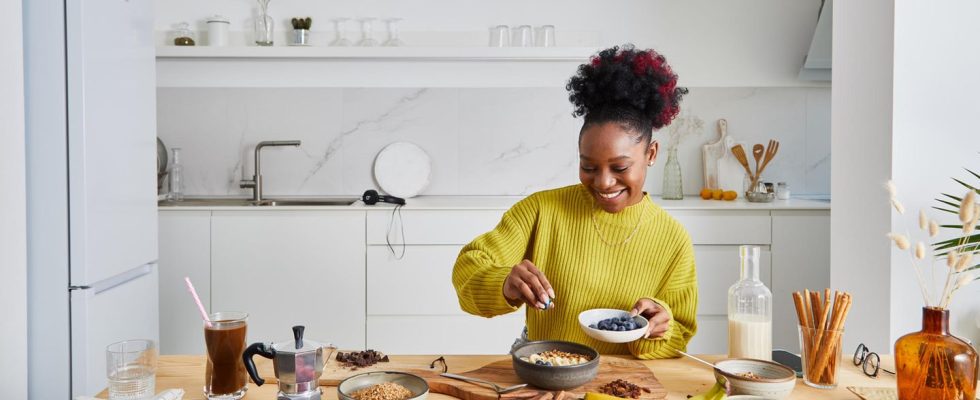A sugar-free diet is good for the body – but it’s not easy to stick to. Nutrition expert Maja Biel agrees star helpful and, above all, actionable tips.
It’s nothing new that sugar isn’t necessarily good for the body. In particular, added sugar, also known as free sugar, causes blood sugar levels to rise quickly, cravings to occur and, if consumed regularly, weight to increase. A sugar-free diet is intended to avoid these negative effects. Read below how you can manage to avoid sugar, whether you really need to avoid all types of sugar and which recipes you can cook.
What types of sugar are there?
In order to be able to eat a sugar-free diet, it is important as a first step to know what types of sugar there are and which ones can be avoided. Nutritionist Maja Biel explains this star “Sugar means carbohydrates. On the one hand, there is industrial sugar. Here the carbohydrates, i.e. sugar, were isolated, industrially, from sugar beets or sugar cane, for example. This type of sugar is sucrose.” When people talk about sugar, they usually mean white table sugar.
There are also more industrially produced isolated species, says the expert. At a glance these are: glucose, fructose, sucrose. But honey, syrup, fruit juice concentrates and other things are also included when talking about free sugar – i.e. the sugar that should be left out of a sugar-free diet.
Maja Biel is an ecotrophologist with her own practice for nutritional therapy in Hamburg. On your website She also offers online nutritional advice.
© private
“And then there is sugar that occurs naturally in foods. For example, the fructose in apples. The difference is always that the sugar is in a combination of other nutrients: vitamin B, folic acid, potassium, for example. Another example would be The milk sugar, lactose, which also occurs naturally in milk. It also contains proteins, fat and other nutrients. To keep it simple, I would always differentiate between these two types of sugar: firstly, the natural sugar in natural foods Combined with other nutrients, and then the isolated sugar, i.e. industrial sugar, so to speak.”
What types should I avoid on a sugar-free diet?
“The exciting question is how sugar-free diets are interpreted. There are, for example many books about a sugar-free diet or stories from some people around you. When we say no, we usually mean white table sugar, but also something like agave, corn extract, fructose syrup or anything that is added. Sometimes people just leave out the white sugar and replace it with honey or something else – which isn’t very effective.” Sometimes people also like to use dates, which, however, also contain a lot of concentrated sugar. “I’m not in favor of to be completely dogmatic and to forbid everything from happening. But you should keep in mind: This is also sugar.”
Instead of simply replacing white sugar with other types of sugar, Maja Biel recommends something different when following a sugar-free diet: “I would definitely continue to recommend fruit because it also contains many other important nutrients: vitamins, minerals, etc. Fruit also has a more natural, lighter sweetness.” This allows you to gradually reduce the level of sweetness.
If you want to stick to a sugar-free diet, it is also important to think about products that contain a lot of sugar, even though they may not taste that sweet. “Something like ketchup or frozen pizza. But also fruit yoghurt, muesli bars, muesli, store-bought smoothies. You might think: ‘Oh, it’s fruit, it’s healthy’. But fresh fruit is the better choice.”
What positive effect can (largest) renunciation have?
If you avoid sugar as much as possible, you will notice some benefits. The expert also knows this: “Anyone who has ever given up sugar for a long time will know that the sweetness level is reduced and that sweets taste much sweeter than usual. The craving for them decreases at some point.” Weight loss can also be associated with the new diet. “Cravings can be reduced. If, for example, you eat a chocolate bar every now and then throughout the afternoon, your blood sugar constantly goes up and down and this means you always crave more. This doesn’t happen with a sugar-free diet.”
Positive effects can also be that you can concentrate better and have a more stable energy level. “You usually feel more balanced, happier. Depending on how much sugar you ate beforehand, it also has positive effects on the intestinal microbiome, the bacteria, the entire intestinal flora.” The risk of diabetes can also be reduced. As well as the risk of getting tooth decay. “But I have to say, all of this is also possible with sugar in the diet.” It usually depends on the amount of consumption.
For guidance: The World Health Organization (WHO) recommends that adults should consume a maximum of 25 grams of added sugar per day. Anything above that is therefore harmful to health. Excessive consumption of sugar, for example, is considered the main driver for the development of particularly unhealthy belly fat. So doing without as much as possible can only be a good thing.
Can a sugar-free diet be problematic?
Eating a completely sugar-free diet has many positive effects. However, the change is usually not entirely unproblematic. Biel explains: “There may be a habituation effect. The body, the brain, and above all the psyche get used to the sugar. If you then suddenly give up, there may be small withdrawal symptoms, i.e. an adjustment phase in which you really do feeling: ‘I can’t stand it, I need something sweet now.'” But if you eat filling, nutrient-rich meals, these cravings will eventually go away. However, it can take a few days for the body to get used to it. “Some people even get headaches. It’s like a little sugar withdrawal. But the good news is: It keeps getting better.”
Recipe ideas
If you want to specifically test out a sugar-free diet, you should use foods or recipes that keep you full for a long time. The expert has the following tips: “The best way to start the day is with a filling breakfast. I hear again and again that porridge, for example, simply doesn’t keep you full for long. A filling meal should always contain carbohydrates, protein and fats. So if you go to… oatmeal and a bit of fruit, quark or yoghurt, it becomes round. Or nuts, they also have protein.” Also the addition of sugar-free peanut butteravailable from brands like nu3, can help you stay full and add a little sweetness.
At lunchtime, for example, there could be a bowl with rice, but also protein-containing foods, such as chickpeas, fish, tofu, vegetables. “Vegetables always have a lot of volume but few calories, so they also fill your stomach. It’s a perfect combination.” But you usually need a snack in between. “Otherwise, it’s no wonder when you come home from work hungry that you run to the fridge or open the candy drawer.” A good snack could then be a handful nuts be, with a piece of fruit. “Even with snacks, you should make sure that it doesn’t just consist of carbohydrates. A few blueberries and two pieces dark chocolateFor example.” In the evening it could be a slice of bread with two fried eggs. “Perhaps a salad with that, if you can tolerate it well. Or steamed vegetables. And if you still have a craving for something sweet, a yogurt with a piece of fruit would be a good choice.”
More tips for a sugar-free diet
- A change from one day to the next is usually unrealistic. A Food diary can help you first recognize what your own diet actually looks like and determine what you might want to change about it. Every cola and every piece of chocolate should be recorded. Holding on to it can also help you find out why you just ate a bar of chocolate, says Maja Biel: “Is it because I’m completely starving? Was it emotional eating? Because I’m so stressed? Is it because I Maybe I’m sitting alone on the sofa in the evening and feeling lonely? Then you could see what could be a good alternative? A date, a few blueberries and two pieces of dark chocolate?
- Don’t be too drastic and forbid yourself everything. Sugar should be eaten in moderation and there may be exceptions, such as a birthday. Otherwise, doing without can be somewhat socially restrictive. In addition, complete sugar breaks are helpful to avoid as much as possible in order to regulate the sweetness level down again.
- Individual approaches are helpful: If you can’t stand having a bar of chocolate in your cupboard, you’ll consciously just grab a chocolate bar the next time you go shopping, which can then be eaten in its entirety at home.
Sources used: German Diabetes Society (DDG) / WHO
You might also be interested in:
This article contains so-called affiliate links. Further information are available here.


